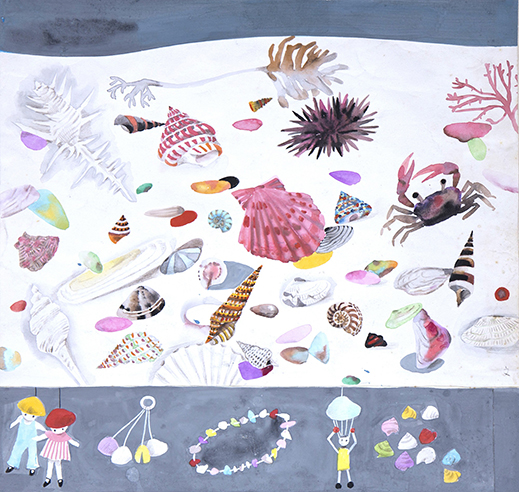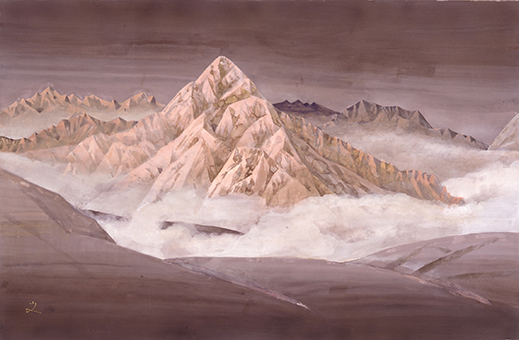 |
|
Here and There introduces art, artists, galleries and museums around Japan that non-Japanese readers and first-time visitors may find of particular interest. The writer claims no art expertise, just a subjective viewpoint acquired over many years' residence in Japan.
|
|
 |
|
|
 |
 |
Starting from Zero: The Liberated Nihonga of Fumiko Hori
Alan Gleason |
 |
|
Spring (1969), color on paper, Meito Art Museum. |
The retrospective of Nihonga artist Fumiko Hori, now at the Museum of Modern Art, Hayama until 25 March, celebrates the achievements of a uniquely unfettered mind -- one that continues to produce incisive art at age 100. Born in 1918, Hori boasts a resume that reads like an encapsulation of Japan's history of the past century. That she is still going strong testifies not only to her physical and mental fortitude but also to a steadfast commitment to her own vision of life and art.
Born into a scholarly family in downtown Tokyo, Hori was encouraged by both parents to think independently. At a tender age she witnessed the attempted military coup d'état of 26 February 1936 firsthand, an experience she says taught her "nothing lasts." When she entered art school she studied Nihonga -- modern "Japanese-style" painting with natural pigments on washi paper or cloth -- and joined a group of radical young artists determined to shake up the Nihonga establishment. This carefree life came to an abrupt halt with the crackdown on "subversives" of all sorts and the outbreak of war. Hori lost both brothers in the war, and her historian father died soon afterward, heartbroken by the loss of all his research materials in the firebombing of Tokyo.
 |
|
Shells on a Beach (1955), watercolor on paper. |
Yet Hori's work hints at none of these sorrows. Her early paintings are colorful and primitivist, reflecting the influence of post-Impressionists like Rousseau and Gauguin. That style stood her in good stead when she began illustrating children's books and magazines after the war to make ends meet. Some delightful examples of her picture-book art are featured in this show. Meanwhile, she continued to paint Nihonga and enter exhibitions, winning a number of awards.
Life took another tragic turn when her husband, a diplomat, died of tuberculosis in 1960. Hori was only 42. Soon afterward she left Japan for the first time, embarking on a journey that took her to Egypt, Europe, the United States and Mexico. Latin America affected her deeply. When she returned to Japan, she says, culture shock prevented her from painting for a time, but eventually she resumed and began painting motifs inspired by her travels. Since then she has led a peripatetic existence, making frequent trips abroad well into her nineties while maintaining studios in Japan on the Pacific coast at Oiso, near Hayama, and in the mountains of Karuizawa. She spent five years in Italy in the late 1980s, traveled to Maya country and the Amazon in the 1990s, and visited the Himalayas several times.
 |
|
Sunset in the Himalayas (Machapuchare) (1998), color on paper, Idumi Art Gallery. |
The Hayama retrospective parades some 150 works by Hori -- mostly Nihonga and watercolors -- in an exhaustive presentation that fills several spacious galleries. The earliest is a 1930 self-portrait; the most recent, Red-Flowering Japanese Apricot, was painted in 2016, when she was 98.
A number of common threads run through this sprawling oeuvre. One is Hori's unwavering devotion to the materials and tools of Nihonga: the pigments made of plants and minerals, the traditional paper backing, the brushes. Another is the colorful diversity of her palette. But perhaps the most consistent aspect is her love of nature in all its forms, from mountain landscapes to exquisite renderings of plant life worthy of a botanist.
|
Blue Poppy in the Himalayas (2000), color on paper. |
|
Woman in a Burkha Carrying a Caged Blue Bird (2002), color on paper, Yonehachi Group. |
Human figures are few and far between, though some of her most poignant works are of women in native dress in the Middle East. One woman in a face-obscuring burkha carries a caged bird on her head. The trenchant message aside, what is most striking is the contrast of color between the fiery-red burkha and the tiny blue bird.
In 2001 Hori suffered a life-threatening aneurysm; she recovered but the brush with death altered her outlook on life, she says. From this point on she began painting smaller works depicting nature on a more intimate scale: not only flowers and grasses, but also microorganisms, viewed under a microscope -- an interest sparked by her illness. Hori notes, "I have never been much for emotional attachments, but I love the plants and flowers of each season with a passion."
|
The Last Hour of Glamour (2004), color on paper, Nirasaki Omura Art Museum. |
Throughout her life Hori has given herself fiat to paint each picture in the style it demands. At her disposal are formidable skills in both figurative and abstract painting, which she often blends in the same work. Her refusal to confine herself to a particular approach or motif during any given period of her career attests to her fierce and hard-earned autonomy. In a video interview, however, she alludes to another focusing factor: fear. "I approach each work as if I am starting from zero," she says. "At the beginning I am consumed with anxiety. Every work is a clean slate."
Above all, Hori articulates an aversion to glib sentiment. "I don't trust art that is too infused with the biases of the heart. In my work, I want to be like a wild fox." As she approaches the century mark, that spirit continues to roam free.
|
White Japanese Rose and Weeds (2014), color on paper. |
|
Portrait of Fumiko Hori (2013). |
Mention should be made of the glorious natural setting of the museum itself. Opened in 2003, it is the newest among Kanagawa Prefecture's erstwhile triplex of modern art museums, which in addition to the Hayama facility includes an annex in Kamakura (the oldest of the three, also in Kamakura, closed in 2016). The bright, airy structure at Hayama is perched right above Isshiki Beach, a lovely strand extending along Sagami Bay and accessible on footpaths from the museum property. On a clear day the views of Oshima island and Mt. Fuji are spectacular. Hayama is a tony but quiet resort town, home to the Imperial Family's seaside villa (just down the road from the museum) and close to Kamakura but less subject to tourist influxes. Allow yourself some time to stroll its beaches and backstreets after a visit to the museum.
|
The restaurant at the Museum of Modern Art, Hayama, overlooking Sagami Bay with Mt. Fuji in the distance. Photo © Norihiro Ueno |
All artworks shown are by Fumiko Hori; all images are courtesy of the Museum of Modern Art, Hayama. |
 |
| HORI Fumiko |
| 18 November 2017 - 25 March 2018 |
| The Museum of Modern Art, Hayama |
2208-1 Isshiki, Hayama, Kanagawa Prefecture
Phone: 046-875-2800
Open 9:30 a.m. to 5 p.m.; last admission at 4:30 p.m.
Closed Mondays and New Year holidays (29 December - 3 January)
Transportation: 20 minutes by bus or 10 minutes by taxi from Zushi Station on the JR Yokosuka Line (1 hour from downtown Tokyo) |
|
|
|
| |
 |
Alan Gleason
Alan Gleason is a translator, editor and writer based in Tokyo, where he has lived for 30 years. In addition to writing about the Japanese art scene he has edited and translated works on Japanese theater (from kabuki to the avant-garde) and music (both traditional and contemporary). |
|
|
|
|
|
|
|
|
|
 |
|